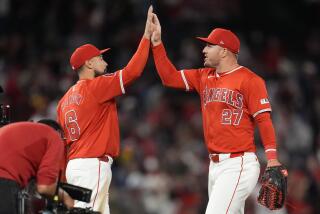The Smart Money Is Still on Scioscia
- Share via
What Mike Scioscia draws from a lineup, from a whole roster, is not by intent anti-Moneyball, but in the city of MoneyPaul, in the division of its spiritual authority, there it is.
Late Sunday night, Billy Beane’s Oakland Athletics undone for the second time in three games, the Angel manager’s duffel bag sat stuffed and leaning into a nine-day trip through New York, Minnesota and Seattle. The itinerary, beginning with Monday’s 10 a.m. flight, lay upon it.
Scioscia’s Angels, on a choppy course through three weeks, are 11-8 and again lead the American League West, which they won on the next-to-last afternoon of last season. They are again what they are; on-base poor, scoring-position rich, contact-driven and extra-base ambitious.
Perhaps little of it makes sense to some of the statistical gatekeepers of the new generation, or aligns with the philosophies in the pages of “Moneyball,” but it reveals Scioscia’s Dodger upbringing, and is particularly convenient at a time when Scioscia’s lineup offers almost no alternative.
The season after the Angels walked and struck out fewer times than any team in the American League, led the league in stolen bases and committed its fewest errors, they are again on the same track, playing away from many of the Moneyball tenets, of walks and on-base percentage and conservative baserunning and letting the defense fall where it may.
They have not yet found their offensive soul exactly. Too often the order waits for Vladimir Guerrero’s turn, Steve Finley’s April is abysmal even by his April standards, Dallas McPherson left his swing in Salt Lake City, Adam Kennedy hasn’t had an at-bat, and the next home run by a designated hitter will be the first.
And still this is Scioscia’s offense, Scioscia’s team, hard contact over walks, basepath savvy over plodding, out-conscious safety. The players conform to the philosophy, the philosophy binds the players, and Scioscia runs it all.
Bench coach Joe Maddon said, “It’s not ‘Don’t walk,’ it’s ‘Don’t strike out.’ ”
Very often, hitters’ counts become balls in play, rather than walks. The A’s walked 158 more times than the Angels last season, already have 12 more walks this season, and in that time have scored 65 fewer runs. The difference in on-base percentage is minimal.
It’s not that the A’s don’t play as hard, they just play differently, and by design.
“Our on-base percentage is relatively low,” Scioscia said. “But the number of times we’re in scoring position is incredible. That’s where we make up for the perception that as a team we don’t walk a lot and swing the bats. We get into hitters’ counts, we get a pitch to hit and we usually put it in play hard. I’m not going to sit here and tell you on-base percentage isn’t important. But there are things you can compensate with if your on-base percentage isn’t off the charts. What’s more important is getting guys in scoring position and getting runs. ...
“There are some things that are very, very clear about Moneyball. You won’t ever hear me knock on-base percentage. But I think the parameters in running the bases, where you’re worried about giving up outs, I don’t know if I agree with that. I don’t know if you can cookie-cutter an offensive philosophy.”
From memory, Scioscia said the Angels advanced from first to third on singles 99 times last season. They were thrown out at third six times. The A’s, he said, were successful 34 times in 36 tries. So the Angels sacrificed four outs to the A’s over the course of the season, and finished a game ahead of the A’s, and went to the playoffs for the second time in Scioscia’s five seasons.
Under the influence of Beane disciple Paul DePodesta, the Dodgers lean more toward on-base percentage obeisance, and the game is different in the National League. But, Manager Jim Tracy said, for stretches of innings the Dodgers and Angels can play similar baseball, working counts, narrowing strike zones, carrying games on the barrels of their bats.
The Angels, however, are unlike almost any team, he said, in their approach at the plate, their ability to reach base without walks, and their relentlessness once there.
“The mental awareness we have on this ballclub is a real good one, and has been for a few years,” Tracy said. “When you’re playing against a team like that one, you had better. They are forcing your hand. Their philosophy is, the more pressure you put on a defense, sooner or later you’re going to crack it.”
So, the Angels add Guerrero (whose pitch selection sometimes comes down to whether the pitcher lets go of the ball), Finley and Orlando Cabrera; bat Darin Erstad leadoff and wait for Kennedy; and put the ball in play.
“There’s some real traditional wisdom in some of the things Moneyball talks about,” Scioscia said. “But there’s also some things we need to bring in here.... Although the walks aren’t always part of it, we do see them get into hitters’ counts, and when they do get into those counts, they’re usually squaring it.”
*
(BEGIN TEXT OF INFOBOX)
Not on the Money
A team that doesn’t draw many walks, the Angels rely mainly on a high batting average to generate their offense. A look at their AL ranks in key offensive categories since 2002:
*--* Year Avg Walks On Base% Runs W-L 2002 282 (1st) 462 (11th) 341 (4th) 5.25 (4th) 99-63 2003 268 (7th) 476 (9th) 330 (8th) 4.54 (11th) 77-85 2004 282 (1st) 450 (14th) 341 (6th) 5.16 (7th) 92-70 2005 255 (9th) 48 (11th) 308 (10th) 4.84 (6th) 11-8
*--*
More to Read
Go beyond the scoreboard
Get the latest on L.A.'s teams in the daily Sports Report newsletter.
You may occasionally receive promotional content from the Los Angeles Times.






